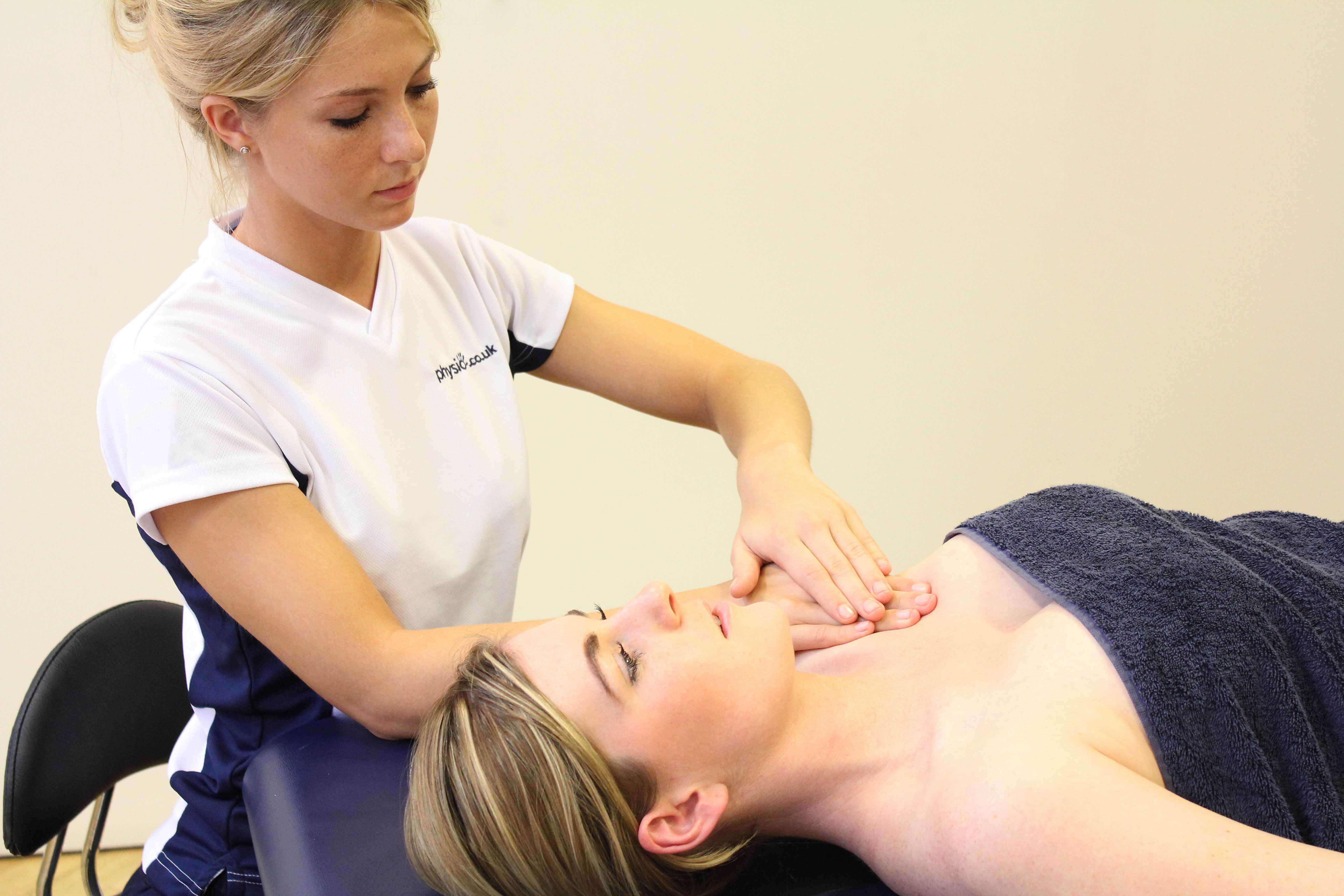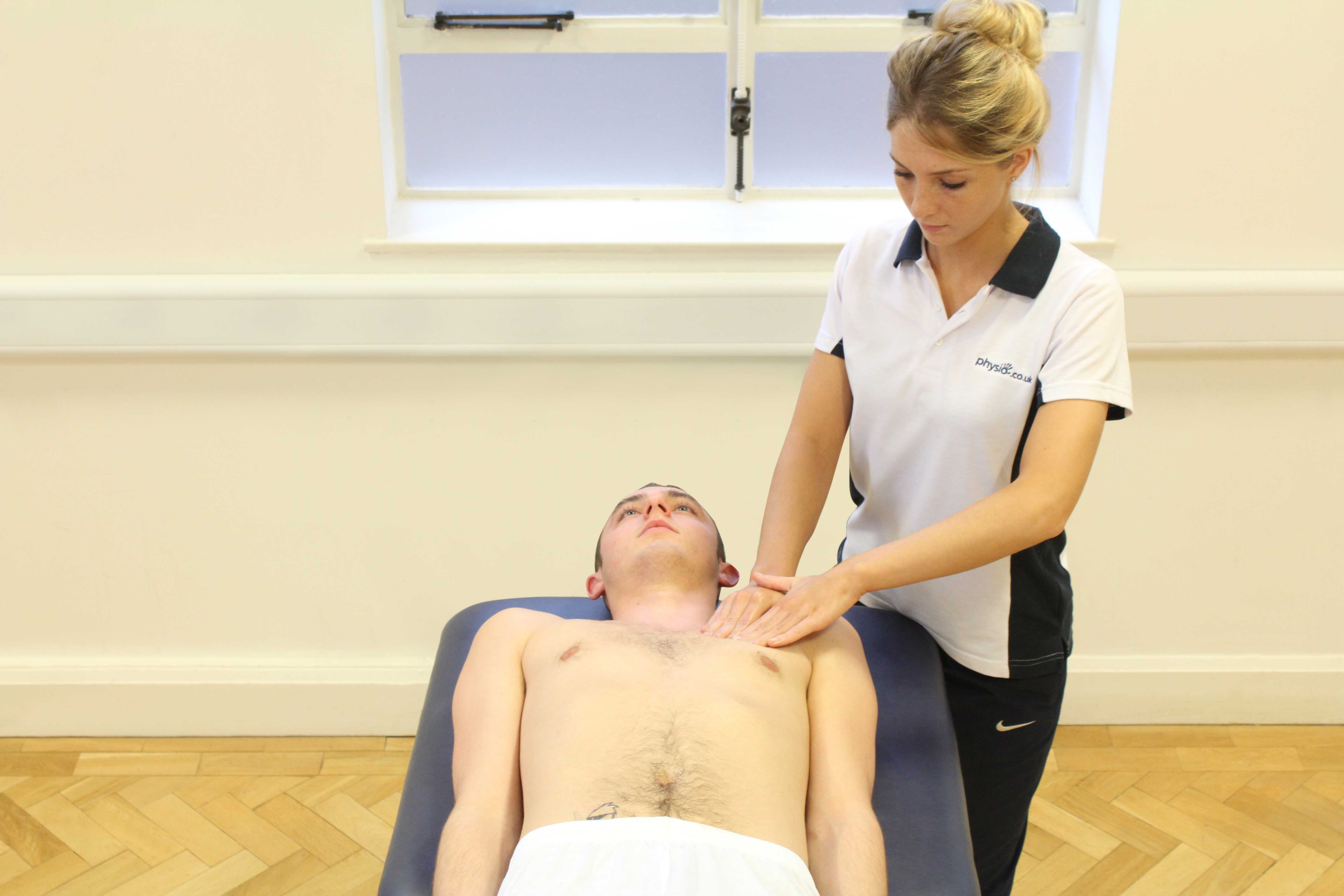- Grade 1 –middle third (shaft) of the clavicle
- Grade 2 – lateral third (acromial end)
- Type 1 – non displaced with ligaments intact
- Type 2 – displaced and the coraco-clavicular ligament is ruptured
- Type 3 – fracture involves he articular surface i.e. AC joint
- Grade 3 – displaced or non-displaced medial third (sternal end)
The most common form of surgery performed is called an ORIF (Open Reduction Internal Fixation). This surgery is performed under anaesthetic. Here, the fracture site is displayed and a metal plate is placed over the fracture. This plate is attached to either side of the fracture through a series of pins. Your wound is then closed and stitched together.
 Above: Soft tissue massage of the clavicle and surrounding connective tissues
Above: Soft tissue massage of the clavicle and surrounding connective tissuesPhysiotherapy prior to Clavicle Fixation
Physiotherapy is regularly used prior to and as an alternative for surgical fixation. With many secondary problems a possibility due to immobility through a sling and acquired abnormal movements as a result of the fracture, physiotherapy becomes essential in preventing any further or future problems. Physio.co.uk will complete a thorough assessment where we will identify weaknesses, deficits, muscle imbalances and movement abnormalities. The highlighted areas will then be addressed and corrected through a comprehensive rehabilitation programme. Treatment will consist of:
- Cryotherapy
- Pain management
- Sling application and management
- Home exercise programme
- Soft tissue release
- Strengthening programme for scapular and surrounding musculature
- Scapular stability
- Advice and post-surgical management
Symptoms following Clavicle Fixation
 Above: Soft tissue massage of the clavicle and surrounding connective tissue
Above: Soft tissue massage of the clavicle and surrounding connective tissueFollowing fixation of your clavicle you will be placed in a protective sling to aid recovery and prevent any movements which could affect the surgery. Symptoms you may experience subsequent to your surgery include:
- Pain
- Swelling
- Numbness (occassionaly an area of numbness occurs around the scar site)
Physiotherapy following Clavicle Fixation
Following clavicle fixation, Physio.co.uk will undertake a thorough examination and assessment of your shoulder highlighting specific therapeutic needs as well as the setting of personal goals. Initial treatment will focus on the management of acute symptoms with a progressive rehabilitation programme developed to address your specific needs and surgery milestones.
Weeks 1-3
During the first 3 weeks following clavicle fixation, Physio.co.uk will manage acute symptoms and minimise post operative complications. Early mobilisation will be encouraged as well as basic stability exercises. Treatment will include:
- Pendular exercises
- Scapular stability
- Taping – muscle re-training and negative inhibition
- Passive and active assisted range of movement below shoulder height.
- Pain management
- Cryotherapy
- Soft tissue release
- Elbow, wrist and hand movement and strength exercises
- Sling management and weaning
- Advice and education
Weeks 4-6
After 3 weeks, you will be discarding your sling, minimising the time your shoulder is supported within it to encourage mobilisation. Physio.co.uk will continue to increase mobilisation to help you achieve functional movement and prevent stiffness and contractures. Strengthening work will begin along with proprioceptive exercises. Treatment will include:
- Continued passive and active assisted range of movement exercises – above shoulder height
- Active range of movement below shoulder height
- Scapular stability through range (below shoulder height)
- Isometric strengthening of rotator cuff, biceps, deltoid
- Soft tissue massage
- Proprioceptive training
- Stretching
Weeks 7-12
Following six weeks of physiotherapy you will have seen a significant increase in movement available and strength of your shoulder. Physio.co.uk will intensify your rehabilitation to ensure you regain full functional use of your arm with a strong focus on attaining your personal goals and previous activities. Treatment will consist of:
- Range of movement exercises to attain full range
- Rotator Cuff strengthening (below and above shoulder height)
- Scapular stability throughout full range
- Strengthening throughout range of shoulder musculature
- Begin integration of sport/task specific exercises
- Muscular endurance
- Encourage functional activities
Weeks 12+
Following 12 weeks of physiotherapy with Physio.co.uk you will have achieved a substantial increase in movement, strength and functional ability. Our goal is to maintain this progression and to achieve full return to all recreational, occupational and sports activities. Physio.co.uk will continue to manage your operation and will provide a comprehensive home rehabilitation programme to ensure the success of your surgery and the return to your previous level of function. Treatment will focus on:
- Achievement of full range of movement
- Advanced strengthening throughout range
- Advanced shoulder stability throughout range
- Advanced proprioceptive training
- Functional training
- Home exercise programme
- Advice and long term management
Summary
Clavicle fixation is a surgical procedure performed when you have severely fractured your clavicle. It involves the attachment of a metal plate to your clavicle through a series of pins to help re-align and stabilise the fracture. When your fracture is compromised through mal-union or non-union, this can dramatically affect movement and function and surgery is needed to restore this to normal. It is essential to have physiotherapy with Physio.co.uk to help rehabilitate and return optimal function. Physio.co.uk will provide a comprehensive, specific rehabilitation programme with a clear focus on personal goals and the restoration of your previous functional level. Call Physio.co.uk now on 0330 088 7800 for more information or to book an appointment please contact us.

 0330 088 7800
0330 088 7800


































